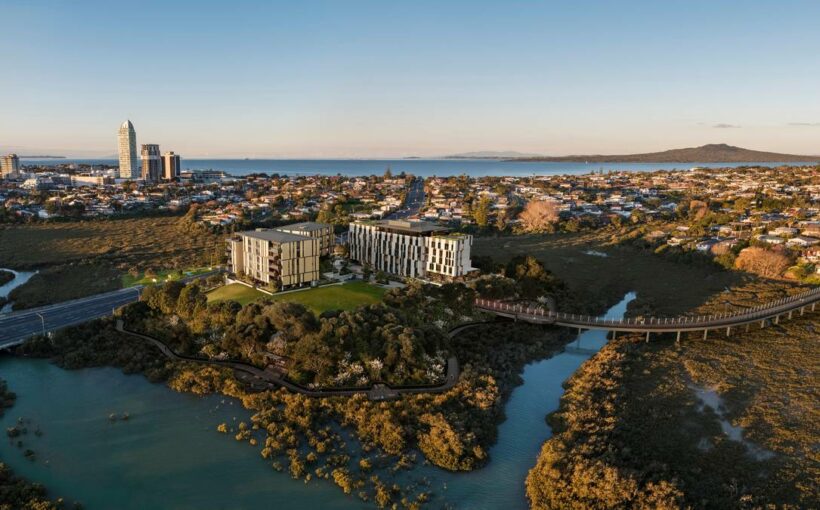Auckland Council has given resource consent for the first stages of a $350 million high-density 543-unit Auckland apartment scheme near a bird nesting ground.
What is now a church site at Takapuna in the coastal marine zone beside the waterfront and near the onramp to the Northern Motorway is planned for development into residential use. Those behind Amaia of Takapuna said they had been granted consent for the first two stages of their programme.
KBS Capital, owned by Brilliant Stone won approval to develop the first two of what will be three blocks on Esmonde Rd’s Harbourside church near kuaka or bar tailed godwit nesting grounds at Shoal Bay.
Initial plans for 48 Esmonde Rd are for two seven-level blocks on the 2.1ha site.
Units of one-bedroom plus a study are being advertised from $789,000, two-bedroom apartments for $989,000 and three bedrooms from $1.75m.
Bar tailed godwits arrive in the spring to nest on the shell banks near the church in Shoal Bay, then return to the northern hemisphere early in the year.
Philip Moll, a conservationist and photographer, has expressed concern about developments and their effects on the fragile environment where birds nest.
He was one of a group who campaigned to get signs erected to highlight the precious wetlands of Ngataringa and Shoal Bays.
Vehicles are sometimes driven onto the shell banks, despite attempts to stop them with barriers and warning signs. Dog owners are also advised to keep their pets on the leash in the areas.
Moll has called the area a biodiversity hotspot under threat from development and said godwits fly non-stop from Alaska to the banks, which are within about 1km of the development site.
Amaia is Māori for halo or lunar rainbow.
KBS said a 3m wide boardwalk and pedestrian and cyclist shared path was planned along much of the site frontage for the new apartments.
That has been designed to connect with future Francis St pedestrian and cycle paths planned by Auckland Council.
“The boardwalk will be custom-designed to ensure the retention of existing trees. Three street trees, two of which are dead, are proposed for removal with new planting proposed along the street frontage and reserve across the road,” KBS said.
The new buildings will have 81 carparks.
The first building will have 37 one-bedroom, 32 two-bedroom, 17 three-bedroom and a 167sq m healthcare facility, 216sq m childcare centre, shop, with and 470sq m for communal and retail areas.
The second eastern-facing building will mainly be visitor accommodation. It will front Esmonde Rd and will have 164 studio and 18 one-bedroom units. On the ground and first floor will be a shared lobby, reception, cafe and a restaurant. The top floor will have four two to three-bedroom penthouse apartments and a shared roof garden.
Stage three will be a further 275 units but does not have council consent.
Earthworks are proposed over a 1.43ha area.
Potential adverse effects are erosion, sediment control, land stability, dewatering and groundwater diversion but the council said these effects were less than minor.
In terms of the godwits and their nesting grounds, Dean Kimpton of Amaia said the developers aimed to create an outstanding and ecologically friendly coastal village in the heart of Auckland.
“This commitment means protection and enhancement where possible of native plants, wildlife and their habitats alongside the site and its coastal fringe. The assessment of environmental effects for the Amaia development fully considered the potential effects of the development on coastal fringe plants and wildlife,” Kimpton said.
An ecological assessment by Wildlands said environmental effects would be less than minor.
“A number of recommendations relating to silt and stormwater management have been made, and these have all been accepted by the developer who is also committed to ensuring Auckland Council standards are met or exceeded,” Kimpton said.
The council said the site was “essentially an island” between the estuary of Shoal Bay adjoining Esmonde Rd and the mangroves on the other side of that road beneath Barrys Point Rd.
The church site now has a paid park-and-ride scheme for 102 vehicles near a bus stop on Esmonde Rd, which leads to a busway beside the motorway.
A display suite is at 10 Northcroft St, Takapuna.
Wildland’s report noted extensive areas of shell banks and intertidal sand and mud in the area, forming a complex habitat for a variety of animals and plants. The intertidal area is an important wading bird feeding ground.
Saltmarsh and mangroves on the margins of the area are protectedby the shellbanks nearer the mouths of the bays and offer a good habitat to secretive coastal fringe birds, it said.
The mangrove shrubland and intertidal area next to the proposed development have been designated as the Shoal Bay Ngataringa Bay special ecological area under the Unitary Plan.
Taranui (caspian tern/hydroprogne caspia), tūturiwhatu (dotterel/ Charadrius obscurus), poaka (pied stilt/Himantopus himantopus), white-faced heron (Egretta novaehollandiae), and kotare (kingfisher; Todiramphus sanctus vagans) fed there, Wildland noted.
Source: Read Full Article

/cloudfront-ap-southeast-2.images.arcpublishing.com/nzme/MDDFOTGX5VZP3MWUPKQ6PCOOFA.jpg)
/cloudfront-ap-southeast-2.images.arcpublishing.com/nzme/NNGVSIC6JUODPBZAUP3AHQDVIQ.jpg)